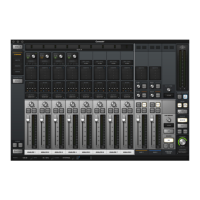Apollo Thunderbolt Software Manual Multi-Unit Cascading 199
Multi-Unit Clocking
All multi-unit clocking is carried via Thunderbolt. All connected Apollo units always clock
(slave) from the monitor (master) unit, whether set to internal or external clock.
Important: Do not interconnect any FireWire, ADAT, Word Clock, or MADI ports
between any Apollo units.
Internal
When multiple units are connected via Thunderbolt, all system clocking and clock
settings are automatically configured by Apollo’s device drivers. The clock setting in
Console’s Info Bar (and its mirrored setting in the Hardware panel within the Console
Settings window) must remain on INTERNAL unless specifically clocking to an external
(non-Apollo) device.
Note: When Apollo’s clock source is set to INTERNAL, “EXT” will illuminate on
the front panel hardware of the expander units.
External
When using an external (non-Apollo) clock, connect the external clock to the monitor unit
only. All connected Apollo units are automatically configured to use the external clock
when Apollo’s Clock is set to EXTERNAL.
Important: When synchronizing to external clock, connect the external clock
source to the monitor unit only. The expander units always synchronize to the
monitor unit.
Multi-Unit Flex Routing
When two or more Apollo rack models are connected, Flex Routing can be used within
each unit. Up to eight output routes can be assigned for each connected Apollo rack
model.
Note: Inputs can only be routed to the outputs of the same unit.

